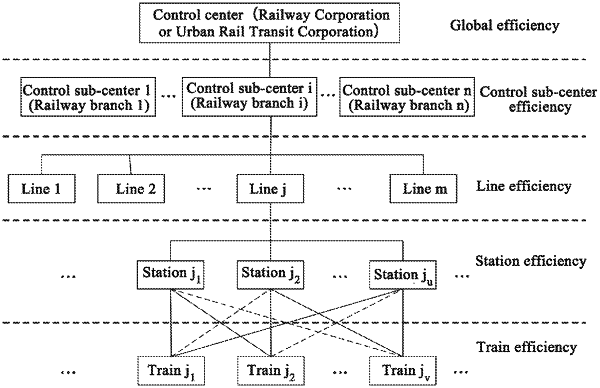| CPC G06Q 30/0202 (2013.01) [G06Q 10/04 (2013.01); G06Q 10/06315 (2013.01); G06Q 10/06393 (2013.01); G06Q 50/30 (2013.01)] | 7 Claims |

|
1. A computer-implemented method of simulating a rail transit system, comprising:
a) determining, at a computer simulation system executed by a processor, a global efficiency of the rail transit system in form of an index vector;
b) around the index vector, establishing, at the computer simulation system executed by the processor, agent models of micro-subjects in the rail transit system to simulate an emergence of the global efficiency based on evolution of intelligent group behaviors by:
establishing a general agent model of the micro-subjects with intelligent perception, communication, behavior autonomy and collaboration abilities, to simulate actual behaviors of the micro-subjects comprising a control center, a plurality of control sub-centers, a plurality of lines, a plurality of stations and a plurality of trains in the rail transit system;
establishing a specific mathematical model of the behaviors of the micro-subjects according to duties, attributes, functions and performances of the micro-subjects; and
generating a control center agent, a plurality of control sub-center agents, a plurality of line agents, a plurality of station agents and train agents by using the established general agent model, and then generating specific virtual entities to simulate the emergence of the global efficiency;
c) transmitting, via network communication, signals in real time among a computer system for the control center, a plurality of computer systems for the control sub-centers, and a plurality of computer systems for the lines, the stations and the trains in the computer simulation system executed by the processor, such that a master-slave cooperation and a parallel cooperation between different computer systems and between different virtual entities are established;
d) establishing an algorithm implemented in the computer simulation system executed by the processor to identify key elements of the emergence of the global efficiency;
e) identifying the key elements by the computer simulation system executed by the processor through a mapping relationship between an optimal global efficiency and adjustable input parameters of the rail transit system;
f) according to the adjustable input parameters of the rail transit system including a dynamic spatio-temporal distribution of passenger or cargo flows and a dynamic road network environment, automatically updating, at the computer simulation system executed by the processor, the global efficiency in real time through autonomous behaviors and mutual cooperation of the micro-subjects until the optimal global efficiency is generated;
g) automatically generating, at the computer simulation system executed by the processor, a systemic solution of the rail transit system based on identification of the key elements affecting the emergence of the optimal global efficiency;
h) determining a systematic solution of the rail transit system comprising train behaviors in a peak season or in an off season according to a transportation demand, and sending, by the control center and the sub-control centers, the systematic solution of the rail transit system to the trains; and
i) controlling, based on the systemic solution of the rail transit system obtained in step g), the trains by automation to take off cars from the trains during the off season or add on cars to the trains during the peak season and to operate according to the train behaviors.
|